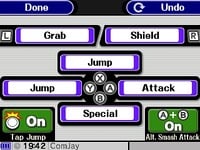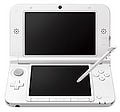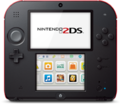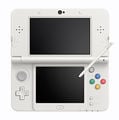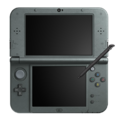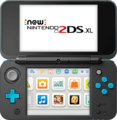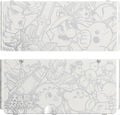Nintendo 3DS
| Nintendo 3DS | |
|---|---|
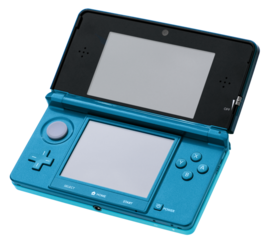 | |
| Manufacturer | Nintendo |
| Type | Handheld video game console |
| Generation | Eighth generation |
| First available | |
| CPU | dual-core ARM11 MPCore |
| GPU | Digital Media Professionals PICA200 GPU |
| Media | Nintendo 3DS cartridge, Nintendo DS cartridge, Nintendo DSi cartridge, SD card (3DS, 3DS XL, 2DS), microSD (New 3DS, New 3DS XL, New 2DS XL) |
| System storage | Included 2 GB SD card (3DS) Included 4 GB SD card (3DS XL, 2DS) Included 4 GB microSD card (New 3DS, New 3DS XL, New 2DS XL) 256 MB internal flash memory Cartridge save |
| Controller input | Nintendo 3DS, Circle Pad Pro |
| Connectivity | Wi-Fi |
| Online service | Nintendo Network, Nintendo Wi-Fi connection (DS mode), Nintendo eShop, Nintendo Zone |
| Backward compatibility | Nintendo DS, Nintendo DSi, NES, SNES (New 3DS only), GBA (Ambassador program only), Game Boy Color, Game Boy, via Virtual Console (now discontinued) |
| Predecessor | Nintendo DS |
| Successor | Nintendo Switch |
| Article on Nintendo Wiki | Nintendo 3DS |
The Nintendo 3DS is a handheld video game console released by Nintendo. The console is the direct successor to the Nintendo DS. It competed in the eighth generation of video game consoles with Sony's PlayStation Vita handheld.
The Nintendo 3DS's defining gimmick is its autostereoscopic 3D, which allows a player to see an alterable level of 3D without the need to wear glasses. For the most part, the console specs are on par with the Nintendo GameCube, though is more capable in certain aspects. Despite this, some things, such as particle effects, are noticeably more limited than on the GameCube, in addition to a lower resolution and lack of anti-aliasing. The 3DS features a wireless mode known as StreetPass, which activates when in sleep mode. This allows for it to passively share information with nearby 3DS systems. similarly to StreetPass, SpotPass allows the 3DS to download data from the internet when the 3DS comes in range with a Wi-Fi hotspot. While moving, the built-in pedometer also allows the user to earn Play Coins. One Play Coin is earned for every 100 steps walked. The 3DS is fully backwards-compatible with the majority of DS and DSi games, though, like the DSi and DSi XL, it lacks a Game Boy Advance port. This means that some DS games that use it, such as Guitar Hero: On Tour cannot be played on 3DS. The Nintendo eShop is the built-in online shopping software. It is the spiritual successor to the Wii shop channel, and the direct successor to the DSi shop. Similarly to them, it allows for the download of older titles via Virtual Console, in addition to the DSiWare returning. Unlike prior storefronts, games can be purchased digitally, The first of which being New Super Mario Bros. 2. Early adopters of the 3DS prior to its price drop could claim free GBA games via the ambassador program.
Speculation on a successor to the DS began in late 2009. Nintendo first spoke of the console at their annual press conference prior to E3 2010. A year later, Nintendo released the system in Japan on February 26, 2011 and to North America on March 27, 2011.
A second model of Nintendo 3DS, the Nintendo 3DS XL, was released on July 28th in Japan and Europe, in North America on August 19th, and in Australia on August 23. Like the Nintendo DSi XL, they boast larger screens than the original Nintendo 3DS. In addition, the internals were tweaked, and the stylus placement has been reverted back to its placement on the original DS. A third variation of the 3DS, called the Nintendo 2DS, was released on October 12, 2013 in all regions except in South Korea and Japan, where it was released on December 7, 2013 and February 27, 2016, respectively. It is considered a reduced-cost Nintendo 3DS, and as the name suggests, lacks the option for 3D visuals. Rather than using a clamshell design, it used a flat, simplistic one. It also requires sleep mode to be accessed through a switch.
In the Japanese Nintendo 3DS Direct on August 29, 2014, the fourth and fifth models (the New Nintendo 3DS and New Nintendo 3DS XL) were announced, released in Japan on October 11, 2014 and in Australia on November 21, 2014, with Europe and North America getting the handhelds on February 13, 2015. However, in North America, only the XL model was released at launch. The standard-sized model was released on September 25, 2015 in special bundles such as Animal Crossing: Happy Home Designer. Both models have ZL and ZR buttons, and a C-Stick. They boast more powerful hardware being even more similar to the GameCube, with a better processor, and more RAM. They also have a tweaked button layout, with different positioning of some buttons. other changes include a new automatic brightness feature that tweaks the light depending on surrounding light levels, and 3D visuals that can be seen from a wider range of angles without getting blurry. Custom faceplates are available for the regular New Nintendo 3DS, but not the XL version due to size difference. The New 3DS also has built-in amiibo compatibility, whereas the original 3DS models require a later released adapter to interact with the figurines. A subsequent revision, the New Nintendo 2DS XL, would be released in mid-2017 worldwide, featuring a slimmer, more traditional design than the original 2DS, albeit with the top screen resembling a smartphone. As with the 2DS, it lacks the 3D visuals entirely.
The Nintendo 3DS line was discontinued worldwide on September 17, 2020.[1] The 3DS sold 75.94 million units worldwide, and stands as Nintendo's worst-selling handheld, in large part due to the adoption of smartphones and tablets; however, it was still successful, beating out the PS Vita by 60 million units.
In the Super Smash Bros. series[edit]
Super Smash Bros. for Nintendo 3DS was released for the 3DS, marking the first time in the series that a Super Smash Bros. game has been playable on a handheld system. The Nintendo 3DS can also be used as a controller in Super Smash Bros. for Wii U by linking the two games. Additionally, a separate app called Smash Controller can be purchased without the need of Super Smash Bros. for Nintendo 3DS. A demo for the game was released in Japan on September 9th, 2014, and special codes for an unlimited demo were sent out on September 12th, 2014. Full access to the demo outside of Japan was granted on September 19th, 2014.
A special version of the Nintendo 3DS XL was also released that featured characters from Super Smash Bros. in poses similar to those of the for Nintendo 3DS boxart. A similarly designed faceplate was released for the standard New Nintendo 3DS.
Ever since Super Smash Bros. 4, many characters originating from Nintendo 3DS games were included as playable characters in the Super Smash Bros. series:
- Dark Pit, Robin, Lucina, Greninja and Corrin in SSB4.
- Chrom, Isabelle, Incineroar and Hero's Luminary costume in Super Smash Bros. Ultimate.
Standard controls[edit]
- The controls are customizable. These are the default controls. Note that the D-pad cannot be customized, and can only be used to perform taunts. The New 3DS's C-Stick cannot be customized either and is used for Smash attacks. ZL and ZR have the reversed function as L and R, as with older for Nintendo 3DS versions.
| Move | |
| Standard attacks | |
| Special moves | |
| Jump | |
| Shield | |
| Grab | |
| Taunt | |
| Pause | |
| Home Menu |
Super Smash Bros. themes[edit]
The Theme Shop, introduced in version 9.0, allows for purchase of various home menu themes. Four themes related to Super Smash Bros. 4 are available, each coming with appropriate music.
| Title | Image | Music |
|---|---|---|
| Super Smash Bros.: Theme 1 | 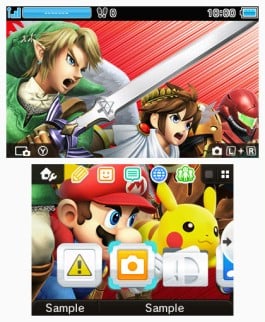 |
Menu (Wii U) |
| Super Smash Bros.: Theme 2 | 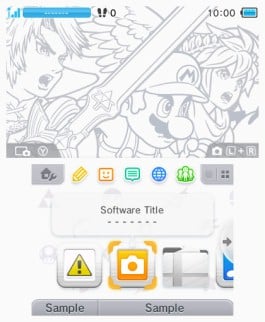 |
Online Practice Stage |
| Super Smash Bros.: Theme 3 | 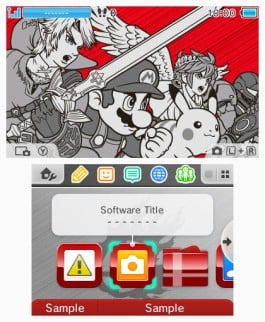 |
Menu (3DS) |
| Super Smash Bros.: Theme 4 | 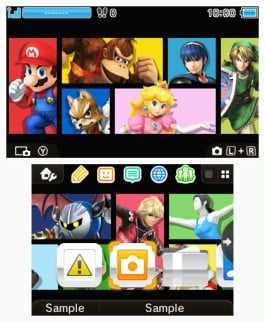 |
Results Display Screen |
In competitive play[edit]
Due to the handheld hardware the game was designed for, the 3DS is the preferred system to play Super Smash Bros. for Nintendo 3DS, especially in tournaments. The game has never been re-released on another system, so players with physical copies can only use the 3DS. While emulators like Citra are known to be accurate, they can experience performance issues depending on the platform's hardware. However, the isolated nature of the game and the aging hardware have forced the competitive scene to consider and experiment with these alternatives before the game becomes harder to use. With the Nintendo Network being shut down on April 8th, 2024, unofficial networks are the only option for online play.
The competitive scene for Super Smash Bros. for Nintendo 3DS, given its parity with the Wii U version, always had a significantly smaller scene. This was due to players generally preferring to play Smash on a big screen, which the 3DS explicitly could not do, but the Wii U did. It was more familiar, used higher-resolution graphics, and had easier-to-access control schemes. The 3DS version was released slightly over two months before the Wii U version, but it was not enough time to grow a scene and very few large tournaments specific to this version have occurred.
There are a few noteworthy aspects specific to the 3DS scene. First off, it has a completely different stage list, leading to a completely different competitively legal stage list. The handheld-exclusive Smash Run has also developed a niche speedrunning community, with players attempting to complete the mode in the fastest time and/or the highest score, along with TASers like DyllonStej Gaming[2] taking the game to its limits. StreetSmash has also developed a niche competitive scene, sometimes seen as side events in major tournaments.
As a controller[edit]
In Super Smash Bros. for Nintendo 3DS[edit]
Due to the 3DS being the only official control scheme for Super Smash Bros. for Nintendo 3DS and being required to play the game, it was essentially the only controller used for the few major tournaments for that game. However, alternatives did exist, such as mods to make a GameCube controller compatible with the 3DS.[3] The button configuration can be altered, though only one custom layout is granted per copy of the game due to the nature of the Nintendo 3DS not needing multiple configurations.
In Super Smash Bros. for Wii U[edit]
The 3DS can be used as a controller in Super Smash Bros. for Wii U either by connecting a copy of both games or via the Smash Controller software. It was released for $0.99 on the Nintendo eShop on June 14th, 2015, and was available until the eShop's shutdown on March 27th, 2023. However, it is also natively accessible in Smash 3DS and is thus physically preserved.
Despite being an official control scheme for Smash Wii U, the 3DS was rarely used in tournaments. This was due to the logistical hurdles of either owning a copy of both games, paying to use the controller functionality, or lacking a Wii U or controller while attending tournaments without a spare being available. Additionally, the controls themselves are generally considered far worse than alternatives due to ergonomic issues and the native absence of a C-stick. However, the New 3DS and its built-in C-stick, as well as the 3DS Circle Pad Pro, improved its viability as a controller and retroactively improved the 3DS entry by making it control more like other games in the series. By this point, however, the Smash Controller feature had been largely forgotten.
Due to the Nintendo eShop being shut down, the only way to access the Smash Controller software, outside of Smash 3DS, is by manual installation through modding the 3DS hardware.
Gallery[edit]
References[edit]
| Nintendo consoles | |
|---|---|
| Home consoles | Color TV-Game 15 · Nintendo Entertainment System · Super Nintendo Entertainment System · Virtual Boy · Nintendo 64 · Nintendo GameCube · Wii · Wii U |
| Handheld consoles | Game & Watch · Game Boy · Game Boy Color · Game Boy Advance · Nintendo DS · Nintendo 3DS |
| Hybrid consoles | Nintendo Switch · Nintendo Switch 2 |
| Controllers and buttons | |
|---|---|
| Nintendo 64 controller | |
| Nintendo GameCube controller | |
| Wii Remote (and Nunchuk) | |
| Classic Controller | L |
| Nintendo 3DS | |
| Wii U GamePad / Wii U Pro Controller | L |
| Joy-Con / Joy-Con 2 | |
| Nintendo Switch Pro Controller / Nintendo Switch 2 Pro Controller | L |
| Third-party controllers | Hori Mini Pad · Arcade controller · Keyboard |
| Other | Smash Controller · Controller modification |













